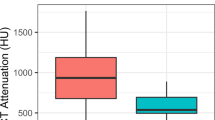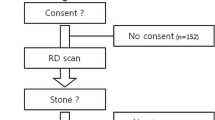Abstract
Purpose
Digital low-dosage, linear slot scanning radiography (Lodox®) is an imaging modality that can emit down to one-tenth the radiation of conventional X-ray systems. We prospectively evaluated Lodox® as a diagnostic imaging modality in patients with ureterolithiasis.
Methods
Conventional kidney–ureter–bladder (KUB) X-ray and Lodox® were performed in 41 patients presenting with acute flank pain due to unilateral ureteral stone confirmed by computed tomography. KUB X-ray and Lodox® images were then reviewed by four blinded readers (urology expert/resident, radiology expert/resident). Identification rates were compared using Pearson’s Chi square test. The impact of different parameters on stone identification by Lodox® was evaluated using logistic regression and generalized linear mixed models. Inter-reader agreement was tested using Cohen’s kappa coefficient.
Results
Median stone size was 5 mm (range 2–12), median stone density was 800 HU (range 200–1500). The identification rates of the urology expert were 68% for KUB X-ray and 90% for Lodox® (p = 0.014), and for all four readers 61% for KUB X-ray and 62% for Lodox® (p = 0.8). Radiation exposure for KUB X-ray and Lodox® was 0.45 mSv (SD ± 0.64) and 0.027 mSv (SD ± 0.038), respectively. Multivariable analyses showed an association between stone identification by Lodox® and stone size (p < 0.001), stone density (p = 0.005), lower body mass index (p = 0.005), and reader (p < 0.001).
Conclusions
The high identification rates and low radiation doses of Lodox® make it a promising imaging modality for the diagnosis of ureteral stones. Further validation in larger cohorts, including performance evaluation for renal stones, is warranted.
Trial registration


Similar content being viewed by others
References
Scales CD Jr, Smith AC, Hanley JM, Saigal CS (2012) Prevalence of kidney stones in the United States. Eur Urol 62:160–165
Romero V, Akpinar H, Assimos DG (2010) Kidney stones: a global picture of prevalence, incidence, and associated risk factors. Rev Urol 12:e86–e96
Chen TT, Wang C, Ferrandino MN et al (2015) Radiation Exposure during the Evaluation and Management of Nephrolithiasis. J Urol 194:878–885
Berrington de Gonzalez A, Mahesh M, Kim KP et al (2009) Projected cancer risks from computed tomographic scans performed in the United States in 2007. Arch Intern Med 169:2071–2077
Koyuncu HH, Yencilek F, Eryildirim B, Sarica K (2010) Family history in stone disease: how important is it for the onset of the disease and the incidence of recurrence? Urol Res 38:105–109
Beningfield S, Potgieter H, Nicol A et al (2003) Report on a new type of trauma full-body digital X-ray machine. Emerg Radiol 10:23–29
Szucs-Farkas Z, Chakraborty DP, Thoeny HC, Loupatatzis C, Vock P, Bonel HM (2009) Detection of urinary stones at reduced radiation exposure: a phantom study comparing computed radiography and a low-dose digital radiography linear slit scanning system. Am J Roentgenol 192:271–274
Evangelopoulos DS, Deyle S, Zimmermann H, Exadaktylos AK (2009) Personal experience with whole-body, low dosage, digital X-ray scanning (Lodox®-Statscan) in trauma. Scand J Trauma Resusc Emerg Med 17:41
Exadaktylos AK, Benneker LM, Jeger V et al (2008) Total-body digital X-ray in trauma. An experience report on the first operational full body scanner in Europe and its possible role in ATLS. Injury 39:525–529
Mulligan M, Smith S, Talmi D (2008) Whole body radiography for bone survey screening of cancer and myeloma patients. Cancer Invest 26:916–922
Whiley SP, Mantokoudis G, Ott D, Zimmerman H, Exadaktylos AK (2012) A review of full-body radiography in nontraumatic emergency medicine. Emerg Med Int 2012:108129. https://doi.org/10.1155/2012/108129
Pitcher RD, van As AB, Sanders V et al (2008) A pilot study evaluating the “STATSCAN” digital X-ray machine in paediatric polytrauma. Emerg Radiol 15:35–42
Samei E, Saunders RS, Lo JY et al (2004) Fundamental imaging characteristics of a slot-scan digital chest radiographic system. Med Phys 31:2687–2698
American College of Surgeons (1993) Committee on trauma, abdominal trauma, advanced trauma life support program, 7th edn. American College of Surgeons, Chicago, pp 141–155
Turk C, Knoll T, Petrik A, et al. European association of urology: EUA guidelines on urolithiasis 2016. http://uroweb.org/guideline/urolithiasis. Accessed Mar 2016
ICRP Publication 103 (2007) The 2007 recommendations of the international commission on radiological protection. Ann ICRP 37:1–322
Deak P, Smal Y, Kalender W (2010) Multisection CT protocols: sex and age-specific conversions factors used to determine effective dose from dose-length product. Radiology 257:158–166
Le Heron JC (1992) Estimation of effective dose to the patient during medical X-ray examinations from measurements of the dose-area product. Phys Med Biol 37:2117–2126
Cohen J (1960) A coefficient of agreement for nominal scales. Educ Psychol Measur 20:37–46
Landis JR, Koch GG (1977) An application of hierarchical kappa-type statistics in the assessment of majority agreement among multiple observers. Biometrics 33:363–374
Heidenreich A, Desgrandschamps F, Terrier F (2002) Modern approach of diagnosis and management of acute flank pain: review of all imaging modalities. Eur Urol 41:351–362
Chugtai MN, Khan FA, Kaleem M, Ahmed M (1992) Management of uric acid stone. J Pak Med Assoc 42:153–155
Pearle MS, Goldfarb DS, Assimos DG et al (2014) Medical management of kidney stones: AUA guideline. J Urol 192:316–324
Kennish SJ, Bhatnagar P, Wah TM, Bush S, Irving HC (2008) Is the KUB radiograph redundant for investigating acute ureteric colic in the non-contrast enhanced computed tomography era? Clin Radiol 63:1131–1135
Worster A, Preyra I, Weaver B, Haines T (2002) The accuracy of noncontrast helical computed tomography versus intravenous pyelography in the diagnosis of suspected acute urolithiasis: a meta-analysis. Ann Emerg Med 40:280–286
Niemann T, Kollmann T, Bongartz G (2008) Diagnostic performance of low-dose CT for the detection of urolithiasis: a meta-analysis. Am J Roentgenol 191:396–401
Kluner C, Hein PA, Gralla O et al (2006) Does ultra-low-dose CT with a radiation dose equivalent to that of KUB suffice to detect renal and ureteral calculi? J Comput Assist Tomogr 30:44–50
Van Der Molen AJ, Cowan NC, Mueller-Lisse UG, Nolte-Ernsting CC, Takahashi S, Cohan RH (2008) CT urography: definition, indications and techniques. A guideline for clinical practice. Eur Radiol 18:4–17
Ferrandino MN, Bagrodia A, Pierre SA et al (2009) Radiation exposure in the acute and short-term management of urolithiasis at 2 academic centers. J Urol 181:668–672
Fahmy NM, Elkoushy MA, Andonian S (2012) Effective radiation exposure in evaluation and follow-up of patients with urolithiasis. Urology 79:43–47
Author information
Authors and Affiliations
Contributions
SF: data collection, manuscript writing, and data analysis. EG: data collection and manuscript editing. AB: data collection and manuscript editing. VO: data collection. SM: project and protocol development and data collection. AKE: data collection and manuscript editing. AC: data analysis, data collection, and manuscript editing. GNT: project development and manuscript editing. BR: project and protocol development, data management and collection, data analysis, manuscript writing and editing.
Corresponding author
Ethics declarations
Conflict of interest
The authors declare that they have no conflict of interest.
Informed consent
Informed consent was obtained from all individual participants included in the study.
Human rights
All the procedures performed in studies involving human participants were in accordance with the ethical standards of the institutional and/or national research committee and with the 1964 Helsinki Declaration and its later amendments or comparable ethical standards.
Additional information
Publisher's Note
Springer Nature remains neutral with regard to jurisdictional claims in published maps and institutional affiliations.
Rights and permissions
About this article
Cite this article
Fiechter, S., Geissbühler, E., Bähler, A. et al. Identification of ureteral stones at reduced radiation exposure: a pilot study comparing conventional versus digital low-dosage linear slot scanning (Lodox®) radiography. World J Urol 38, 1065–1071 (2020). https://doi.org/10.1007/s00345-019-02803-w
Received:
Accepted:
Published:
Issue Date:
DOI: https://doi.org/10.1007/s00345-019-02803-w




